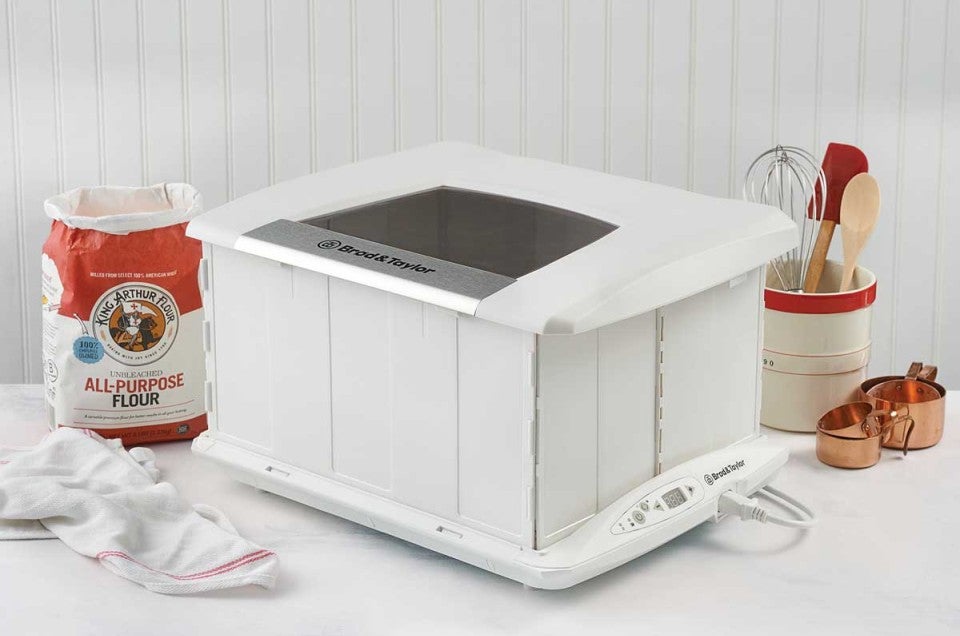


You're making yeast bread in the dead of winter. Your house is a bracing 62°F. The particular recipe you're following – Jewish Rye Bread – says you should let your starter rise overnight, "preferably at a temperature of 70°F." Farther on, the recipes says "Allow the dough to rise in a warm spot (78°F) for 1 hour."
Yeast dough's secret weapon to the rescue!
There are a number of ways to get yeast dough to rise in an inhospitable (read: cold) environment – and you've probably discovered most of them, if you bake bread year-round and live north of the sunny South.
The minimally pre-heated oven. The microwave with boiling water. Next to the woodstove, over the hot-air register, snuggled into a heating pad – even on top of the hot water tank in the cellar.
But these can be hit-or-miss options when you're looking for a specific temperature, one you can rely on to remain constant over the course of your yeast dough's rise. Or, in the case of sourdough starter, for as long as it takes to reactivate, with feedings that can stretch over several days.
So, yeast dough's secret weapon is...
A climate-controlled electric bread proofer, where your dough, shaped loaves and rolls, and sourdough starter can rise at any temperature between 70°F and 120°F – your choice, not the weather's.
How do I love my proofer? Let me count the ways...
When you're on a tight schedule, and absolutely need your rolls to be ready for the potluck supper at 6 p.m., you don't have time for yeast to do any cold kitchen-induced dawdling.
See the two bowls of dough above? The one on the left, proofed in the proofer, doubled in bulk exactly when the recipe said it should, in 90 minutes. The one on the right (shown at the 90-minute mark) took about 30 minutes longer to double.
Maybe you have 30 minutes to spare (plus probably another 30 minutes once you've shaped the rolls) – but when I'm juggling too many projects in too tight a schedule, I appreciate the "specificity" of timing the proofer offers.
Finding a way to cover a delicate pan of rising rolls – or a buxom domed loaf – can be problematic. Towels stick; plastic wrap, even when greased, can cling. There's nothing so disappointing as carefully lifting plastic off a trembling ciabatta, only to see it catch in the center and pffffftt... the whole loaf deflates.
The proofer comes equipped with a shallow tray in its base for water. Between the heated environment, the walls and lid, and the water, your rising dough is both protected from drafts, and kept warm and moist. It just doesn't get any better, environmentally speaking.
If you're a dedicated bread baker, you'll inevitably run across recipes with VERY SPECIFIC RISING TEMPERATURES.
Gosh, sometimes you'd think yeast is a pampered poo-bah, when in reality it's a good sport, surviving (if not quite thriving) under all kinds of conditions...
Nevertheless, if you bake many artisan-style breads – particularly those involving a starter – you'll likely want to begin by following a recipe exactly as written, rather than winging it. So when your recipe calls for a starter to be held overnight at 70°F – you can do just exactly that.
The proofer holds a couple of 9" x 5" loaf pans. Or a 9" x 13" pan. With the optional shelf, you can do two 9" round pans of rolls – or two 9" x 13" pans. I can even wedge my 12" pizza pan in there.
Baking in tight quarters? Need all the work space you can get? Set the proofer outside the kitchen somewhere, and never again have to deal with counters full of rising dough.
The whole thing packs away inside itself, and folds flat for storage. Ready to proof some dough? Simply open the proofer, unfold the walls, and you're good to go.
OK, this post is supposed to be all about yeast bread. But I couldn't resist showing you how else I use my bread proofer. Like making homemade yogurt. And tempering chocolate. And then there's the quirky starter for lost-in-the-mists-of-time salt-rising bread. To say nothing of feeding my just-plain-sourdough starter. See everything I've done with my proofer in Proof(er) positive: bread and chocolate (and yogurt, too).
Looking for more information? Read a detailed description of our bread proofer.








